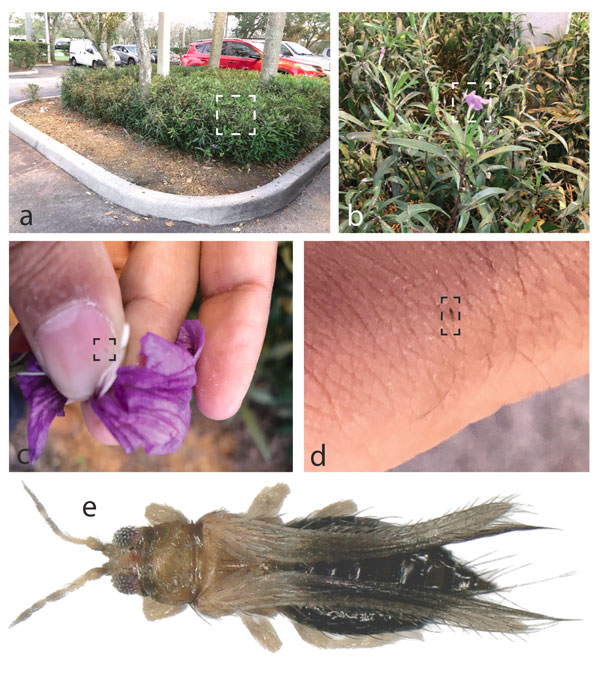6/1/2023
Thrips parvispinus: An Emerging Invasive & Regulatory Pest in the United States
Muhammad Z. Ahmed, Cindy McKenzie & Lance S. Osborne

Thrips parvispinus, commonly known as pepper thrips, is one of the smallest, dark-colored thrips species. It’s native to the Asian tropics and has been reported in at least 17 countries from five continents (Africa, Asia, Australia/Oceania, Europe and North America) in the last three decades.
One of its invasive characteristics is its polyphagous nature and it has been reported feeding on at least 43 plant species from 19 families. A website containing information about thrips early diagnostics, field guide, scouting, biology and management options is available to help extension agents, ornamental and vegetable growers, master gardeners, and the public to identify and aid in this pest’s management in an effort to halt its spread in the U.S.
The website also features high-resolution images and videos of T. parvispinus and the damage it causes, as well as a scouting sheet to differentiate it from other dark-colored thrips species that may also be in the field and landscape. This information will be critical in developing effective control strategies and preventing the further spread of this invasive species in the U.S.
Pictured: A) New county record for Thrips parvispinus associated with heavy feeding damage on Mexican Petunia/Mexican Bluebell (Ruellia) hedge in urban shopping mall landscape in Port St. Lucie, Florida; B) Close-up of thrips damage on Ruellia; C) Close-up of Ruellia flower and adult female thrips on thumbnail; D) Close-up of adult female thrips compared to arm hair (very small—1 mm); E) Adult female Thrips parvispinus.
Early detection is very challenging due to its small size and cryptic nature. While damage symptoms are the most noticeable indicators of infestation, thrips may not be noticeable until considerable damage has already been sustained.
In ornamental plants, we observed this species is usually hidden in flowers as soon as they bloom and recommend inspecting flowers carefully, even if there are no signs of damage. This species reproduces rapidly, with subsequent generations appearing within two weeks, so early detection is crucial.
It’s important to note that T. parvispinus has no known natural enemies in Florida, making early detection and prevention even more crucial. As they say, an ounce of prevention is worth a pound of cure, and this is particularly true when dealing with T. parvispinus.
In south Florida, T. parvispinus has been established in at least four counties (Martin, Miami-Dade, Palm Beach and St. Lucie) and has been intercepted in at least 22 counties (research surveys and Department of Plant Inspection) all over Florida for a total of 26 positive county detections. After a field detection in Palm Beach County bell peppers, we extensively surveyed retail box stores countywide and found T. parvispinus in 14 of the 15 stores surveyed in February and March of this year.
In April, we surveyed retail box stores in nine northern counties along the I-75, I-10 and I-95 corridors previously not positive for the thrips (Alachua, Brevard, Duval, Marion, St. Johns, Flagler, Volusia), including two counties on the state line that border Georgia (Columbia and Nassau), and found this pest in every store we surveyed. Two host plants that we found consistently positive in these stores were dipladenia and gardenia, and we highly recommend others inspect them carefully, especially in the flowers where they’re most abundant and easily detected.
A team of researchers has been actively working on the emergency situation in Florida and other places nationally and internationally. Dr. Cindy McKenzie is leading the host plants and geographical surveys to capture its distribution nationally. Dr. Muhammad Ahmed is developing a field guide and field scouting criteria to help in its field diagnostics. Dr. Lance Osborne is co-chair of the task force developed on this thrips nationally and internationally with colleagues in the Division of Plant Industry and the United States Department of Agriculture. Dr. Alexandra Revynthi (UF/IFAS Tropical Research and Education Center) is working under quarantine conditions conducting leaf bioassays in the lab to test toxicity of available chemical products in ornamental production. And Canadian colleagues who aren’t under quarantine for this pest have provided a lot of relevant information and tested control options, including dipping cuttings being shipped to them specifically from Florida. The results of work conducted in Florida and Canada by Drs. Rose Buitenhuis, Alexandra Revynthi and Sarah Jandricic are available in the Resources Section of the website, as will be other reports we receive from cooperators in the future. GT
Lance S. Osborne is with the University of Florida, IFAS and Mid-Florida Research & Education Center. Cindy McKenzie and Muhammad Z. Ahmed are with the USDA-ARS Horticultural Research Laboratory in Fort Pierce, Florida.